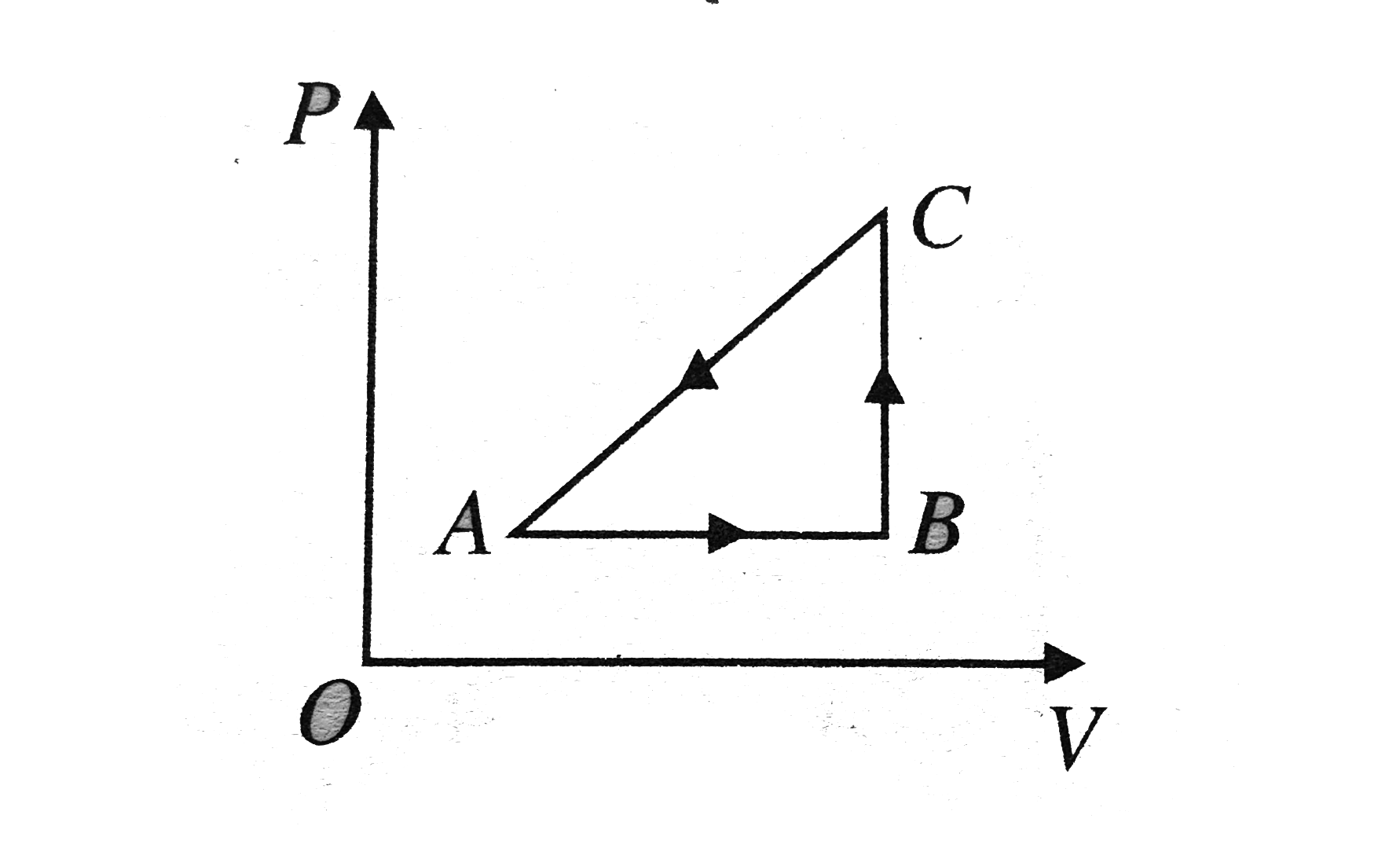An ideal gas undergoes a thermodynamic cycle as shown in Fig. Which of the following statement are correct ?

Straight line AB cannot pass through O.
During process AB, temperature decreases while during process BC it increases.
During process BC, work is done by the gas against external pressure and temperature of the gas increases.
During process CA, work is done by the gas against external pressure and heat supplied to the gas is exactly equal to this work.
The correct Answer is:B, D
For an isothermal process, PV= constant
P=constantV or P∝1V
It means, for an isothermal process the graph between P and 1/V will be straight line passing through origin. Hence, the straight line AB will pass through origin. Hence, option (a) is wrong.
During process AB , the pressure P remains constant but 1/V increases. It means, volume V decreases. Hence, AB is isobaric compression. Since volume of the gas decreases at constant pressure, therefore its temperature decreases. But temperature at C is equal to that of A. Hence during the process BC, the temperature of the gas increases. In face, process BC is an isobhoric heating. Therefore, option (b) is correct. Since the during the process BC, volume remains constant, no work is done by the gas against external pressure. Therefore option (c) is wrong.
During process CA,1/V decreases, it means volume V increases. Since the volume increases, work is done by the gas against external pressure.
Since process CA is an isothermal process, no chage ini internal energy of the gas takes place. Hence, according to the first law of thermodynamics, Q=W+ΔU, heat suplied during this process is equal to work done by the gas against external pressure. Hence, option (d) is correct.
Topper's Solved these Questions
- KINETIC THEORY OF GASES AND FIRST LAW OF THERMODYNAMICSBOOK - CENGAGE PHYSICS ENGLISHCHAPTER - KINETIC THEORY OF GASES AND FIRST LAW OF THERMODYNAMICSEXERCISE - Assertion-Reasoning
6 Videos
- KINETIC THEORY OF GASES AND FIRST LAW OF THERMODYNAMICSBOOK - CENGAGE PHYSICS ENGLISHCHAPTER - KINETIC THEORY OF GASES AND FIRST LAW OF THERMODYNAMICSEXERCISE - Comprehension
56 Videos
- KINETIC THEORY OF GASES AND FIRST LAW OF THERMODYNAMICSBOOK - CENGAGE PHYSICS ENGLISHCHAPTER - KINETIC THEORY OF GASES AND FIRST LAW OF THERMODYNAMICSEXERCISE - Single Correct
140 Videos
- KINETIC THEORY OF GASESBOOK - CENGAGE PHYSICS ENGLISHCHAPTER - KINETIC THEORY OF GASESEXERCISE - Compression
2 Videos
- LINEAR AND ANGULAR SIMPLE HARMONIC MOTIONBOOK - CENGAGE PHYSICS ENGLISHCHAPTER - LINEAR AND ANGULAR SIMPLE HARMONIC MOTIONEXERCISE - Single correct anwer type
14 Videos
Similar Questions
For the circuit shown in Fig. Which of the following statements are correct?

View SolutionAn amplitude modulated wave is as shown in Fig.

Which of the following is/are correct ?
View SolutionA metal sphere is hung by a string fixed to a wall. The forces acting on the sphere are shown in fig Which of the following statements are correct?

View SolutionThe reversible expansion of an ideal gas under adiabatic and isothermal conditions is shown in the figure. Which of the following statement(s) is (are) correct?

View SolutionAn ideal gas undergoes a thermodynamic process as shown in Fig. The process consists of two isobaric and two isothermal steps. Show that the network done during the whole process is
W(Net)=P1(V2−V1)logeP2P1

View SolutionOne mole of a monatomic ideal gas goes through a thermodynamic cycle, as shown in the volume versus temperature diagram. The correct statement(s) is(are) :

View SolutionAn ideal gas undergoes the cyclic process shown in a graph below :

View SolutionAn ideal gas is enclosed in a thermally insulated container. Container is covered by an insulating piston which is connected with spring. Small displacement is given to piston as shown in figure. Which of the following statements is correct? Neglect friction everywhere.

View SolutionFor one complete cycle of a thermodynamic process gas as shown in the P-V diagram, which of following correct?

View SolutionAn ideal gas undergoes a circular cycle as shown in the figure. Find the ratio of maximum temperature of cycle to minimum temperature of cycle.

View Solution
